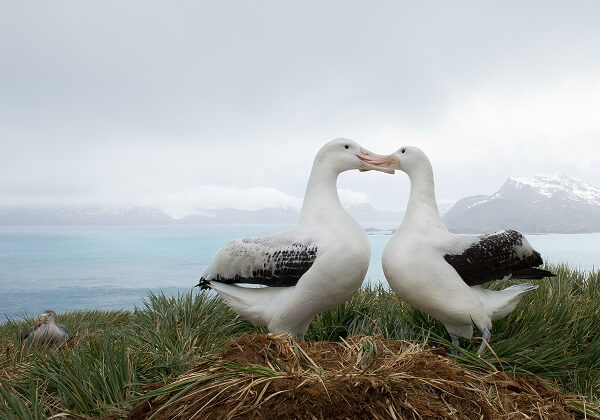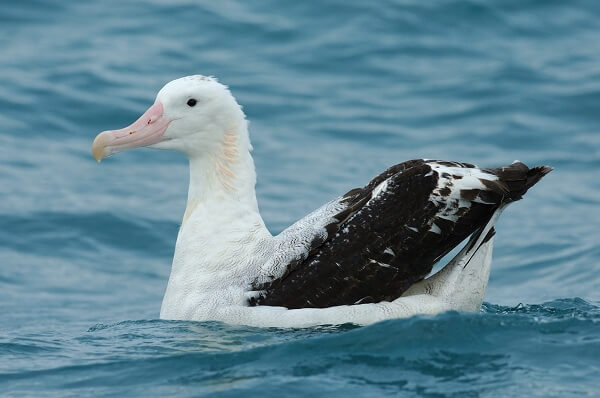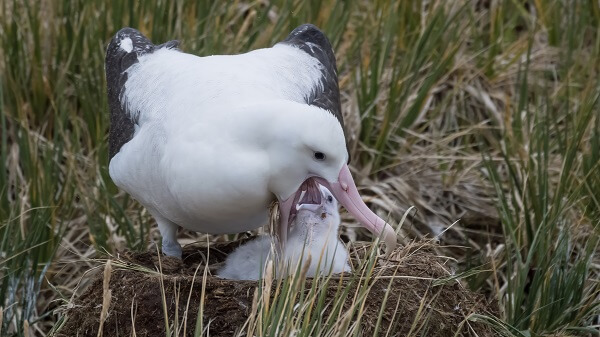
The wandering albatross (Diomedea exulans) is the largest extant bird. These birds spend most of their lives out at sea, using their large wings to ride the ocean’s winds. They can glide for hours without flapping their wings. They are so efficient at flying that they use less energy in the air than they do sitting on a nest. These albatrosses are found mainly in the southern oceans, although they have been seen in all oceans except the North Atlantic. They breed on remote islands found just to the north of the Antarctic circle. When they aren’t breeding, they are largely pelagic and can travel thousands of kilometers from their breeding ground, sometimes crossing the equator. They can fly up to 40km per hour. These birds feed at night and sometimes feed in small groups, making shallow dives while hunting. Their diet consists of cephalopods, small fish, and crustaceans. They also follow fishing boats and other ships in the hopes of feeding on discards and garbage. Sometimes these birds eat so much that they are unable to fly and just have to float on the water. Albatrosses sexually mature around 11 years of age. The males will court the females with elaborate displays and vocalizations. Once the female has chosen her mate, the birds will pair up for life. Mating occurs every two years. The breeding season starts in early November and lasts until March. The birds gather in large colonies on remote islands and build their nests from mud and grass. The female produces one egg, and the parents take turns incubating it. The egg hatches after around 11 weeks. Once the chick is born, the parents take turns hunting and staying at the nest to take care of the chick. These large birds don’t have many predators. However, they are listed as vulnerable as increasing pollution is making it difficult for the birds to find food. As the largest extant bird, the wandering albatross is an excellent example of several biological adaptations. This bird’s biology enables it to live its life at sea, traveling long distances and feasting upon a variety of sea creates. Let’s investigate further. Wandering albatrosses travel thousands of kilometers across the water without setting foot on land. To survive life on the ocean, they have an adaptation that allows them to drink seawater. These birds have a special gland above their nasal passage that excretes a high saline solution. This gland is a part of a desalination mechanism that helps them to remove salt from their bodies, which mainly comes from all the saltwater that they take in when they drink. The salt glands, which are located above the eyes, contain thousands of tiny capillaries known as tubules. These tubules are covered in very thin blood vessels. The glands contain a liquid that has a high salinity level, greater than that found in the blood. Desalination of the blood occurs as a countercurrent exchange. What that means is the salt travels from the blood vessels and through the membranes of the tubules, following a concentration gradient. The salt liquid can then be secreted through a duct towards the tip of the beak, where it is exhaled as a fine mist. This fantastic adaptation enables albatrosses to get their water intake from saltwater. Other aquatic animals, such as marine mammals, do not have salt glands. They meet their water needs through their diet, drinking very little seawater. One morphological adaptation that helps the wandering albatross with its lifestyle is its huge wingspan. They have the biggest wingspan of any extant bird, reaching up to 11 ft. These long-winged seabirds can travel vast distances using two techniques; dynamic soaring and slope soaring. Dynamic soaring is used to gain energy and minimize effort by gliding between air masses of different velocities. On the other hand, slope soaring is when the wind blows into the face of a hill or a cliff, and the airstream is deflected upward. The albatross uses this deflection to gain height, and then it can glide back down to the sea. Aside from making use of different soaring techniques, the albatrosses wing also has a shoulder-lock, which is a sheet of tendon that locks the wing when fully extended. This enables the wing to be kept up and extended without using too much energy, a morphological adaptation they share with the giant petrels. Wandering albatrosses are dependant on wind and waves to remain airborne and are not suited to powered flight. The birds are unable to carry out sustained flapping. If the weather is calm, these birds are forced to rest on the ocean’s surface until the wind picks up again. They can also sleep while resting on the surface. Wandering albatrosses mostly feed on squid, but they will feed on a variety of other prey, including fish, carrion of seabirds, marine mammals, and waste produced by fishing boats. These birds have to fly for extended periods to search for prey and will ingest large amounts of food whenever it is available. The bird’s stomach has an estimated volume of 3 -4 liters, which allows them to swallow large prey items. They can ingest prey items up to 3.2 kg, which is over 30% of their body mass. The stomach acid of these birds enables them to eat these large meals. The pH of their stomach acid is approximately 1.5, meaning that the stomach is very acidic, especially when compared to the stomach acid of other seabirds. Their acidic stomach acid helps to speed up the chemical breakdowns of the food they eat, resulting in very rapid digestion. This enables them to take advantage of the patches of prey that they come across. The acidity of their stomach acid is like that found in vultures that primarily feed on carrion.
Kingdom
Animalia
Phylum
Chordata
Class
Aves
Order
Procellariiformes
Family
Diomedeidae
Genus
Diomedea
Species
Diomedea exulans
Niche
Piscivores and molluscivores
Length
42 – 53 in (107 – 135 cm)
Weight
13.2 – 26.5 lbs ( 6 – 12 kg)
Lifespan
up to 50 years
Social Structure
Solitary when flying but will feed in small groups
Conservation Status
Vulnerable
Preferred Habitat
Out at sea unless breeding
Average Clutch Size
One egg
Main Prey Species
Fish and Squid
Main Threats
Pollution
The Basics

Interesting Insights from the Wandering Albatross!
Salt Gland

Huge Wingspan

Acidic Stomach
